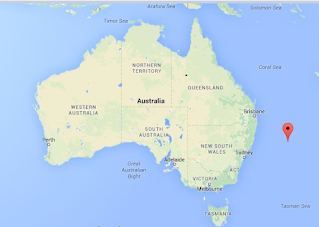 |
| Lord Howe Island |
The story really begins seven million years ago when Lord Howe Island was created by a volcanic eruption. Then it apparently sat there creating its own unique ecosystem until, in 1788, a British ship carrying convicts between penal colonies in modern-day Sydney and Tasmania stumbled across the island (it bears noting that they were clearly lost). Despite careful study, no evidence has been found that aboriginal or native Pacific Islanders had ever been there before these lost Brits, so the environment was pristine.
In the years after its discovery by the British, it became a stopping point for whaling ships. The first permanent colony was formed in 1834, but the population was down to 11 people by 1849. When the Australian Gold Rush struck in 1851 the island again had a population surge as ships carrying would-be miners would put in port there. By the 1860’s, the rush was over and the only ones who were interested in this far, far off place were scientists. Charles Darwin had published his seminal study of evolution, On the Origin of Species, in 1859 and it sparked a rush of scientists seeking their own discoveries.
 |
| Ships carrying gold miners, 1850s |
world throughout time, they have caused (and are continuing to) cause environmental devastation wherever they are. On Lord Howe Island , they
began being a presence in the late 1800s, but the real trouble started in 1918 when the SS Makambo went aground off the coast. Rats left that nearly-sinking ship and proceeded to enjoy the buffet of delicacies that Lord Howe had to offer. They wiped out many species of birds and fauna and raided the islander’s crops. And, of course, they gorged themselves on the delicious Walking Sausages. So much so that they were extinct on Lord Howe by 1920.
 |
| Ball's Pyramid with Lord Howe Island in the distance |
In 2001, even though they’d been on the extinct list for 81 years, a group of Australian researchers decided to check out a nearby rock outcropping off Lord Howe’s coast called Ball’s Pyramid. It’s the remnants of a volcano, known as a sea stack, sea spire or volcanic stack, and it’s the tallest in the world at over 1800 feet. And, as described in this video, it looks like the lair of a super-villain. Over the years there had been a handful of climbers to the pyramid who’d found dead insects, so the scientists decided to venture out there and check it out to see there were any live LHISI.
But they were limited to those areas that required no specialized climbing skills or gear, which greatly limited the search area but still encompassed most of its vegetation. They scrambled around in the day and found frass and eggs, but no adults. Thanks to the original scientists who’d carefully studied the LHISI on its home island, these modern insect hunters knew it was nocturnal, so they returned at night. Moving around carefully with only flashlights to light their way, they discovered a small colony of 24 adults feeding on and living under a single bush (Melaleuca howeana - found only on the pyramid and Lord Howe). How these insects made it across 14 miles of tempestuous ocean is still a mystery.
 |
| At Melbourne Zoo |
Take Care.
Submitted by Pam








No comments:
Post a Comment